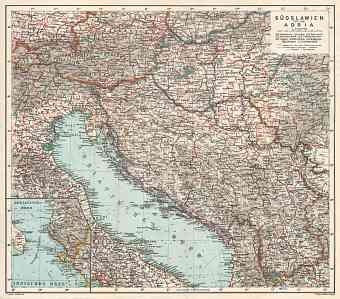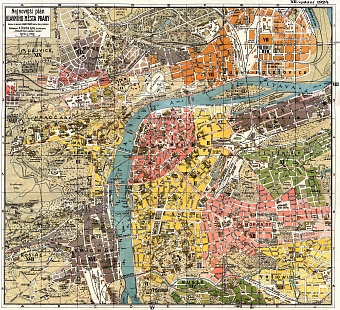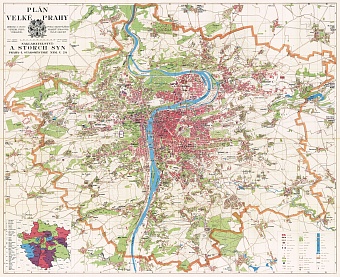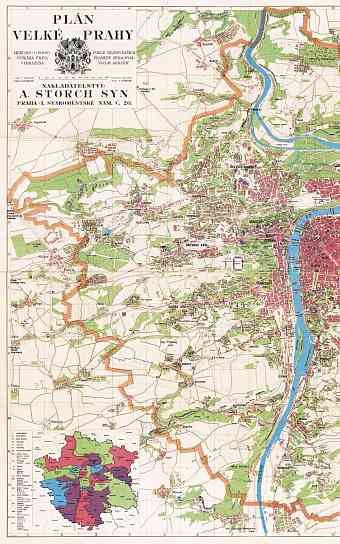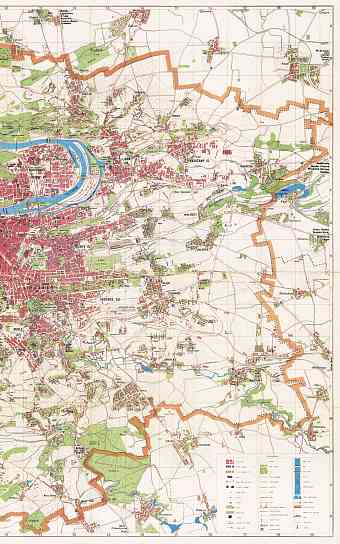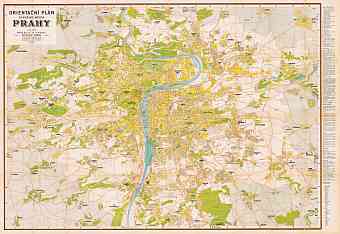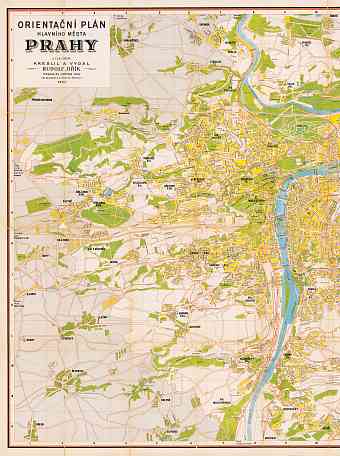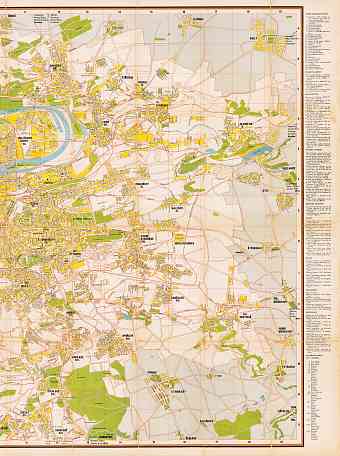Czechoslovakia, different periods (1918 - 1930s). Historical Maps and Plans
Czechoslovakia appeared on the political map of Europe as a fruitful outcome of the struggle of the Czechs against Austrians and the combat of the Slovaks against the Hungarians. With the end of the First World War, the Austria – Hungary Empire collapsed, now becoming seen on historical maps only, and different ethnic groups under it sought liberation, blending into new structures. The independent country of Czechoslovakia was proclaimed following the Pittsburgh Agreement of May 1918 and issuing the Declaration of Czechoslovak Independence by Masaryk, Kramář and Beneš in October 1918.
Following that year, the Paris Peace Conference was convened in the month of January. The Conference was favorable as the establishment of the Czechoslovak Republic was approved including the encompassing of the historic Bohemian Kingdom, Slovakia and Carpathian Ruthenia. The ethnic minorities were placed under the protection of the League of Nations by the Minority Treaty signed by Czechoslovakia on September 10th 1919.
The official Constitution for the newly formed nation was established in 1920 installing a parliamentary system of government. This system led to a development of multi party system with no clear leading political entity. The first democratic election was held in 1920 and Tomáš Garrigue Masaryk was elected to be the country's first president who proved to be efficient in his all his nationalistic undertakings. A coalition government of five Czechoslovak parties was formed under the leadership of the Prime Minister, Antonin Svehla, who led the Coalition government (Petka) for most of the 1920s and the pattern of his politics survived till 1938. Masaryk served as a President of Czechoslovakia till 1935, the year he resigned due to ill health.
His successor, Edvard Beneš was a westbound democratic statesman and he relied on the League of Nations for the security of the new republic and also for the definition of their status quo. An alliance with Yugoslavia and Romania led to the formation of the little Entente. He negotiated with them to counter Hungarian reprisal in 1921.
Czechoslovakia became a new country with diverse ethnic groups under one roof. The leaders needed solution for this multiplicity of cultures for the sake of efficient governance. Therefore, from 1928-1935 the country of Czechoslovakia was divided into four distinct ‘’lands’’ Bohemia, Moravia-Silesia, Slovakia and Carpathian Ruthenia. The national minorities of each group was assured special security and in lands where they constituted less than 20% of the population, they were granted the right to use their native language in their everyday lives without any institutional limitation. In 1926 the German parties participated in the country’s government but the Hungarian parties remained aloof without being hostile.
The conflict began because of the country’s centralized political structure. And many political autonomies erupted such as the Slovak People’s Party.
With the rise of the German dictator Adolf Hitler in 1933, the whole of Central Europe was alarmed by its aggression. Benes adamant to remain faithful to his Western policy ignored the importance of strong Central European alliance. However, he seeked the assistance of the Soviet Union and concluded the inclusion of France. In 1935 a treaty was signed between Soviet Union, Czechoslovakia and France where it was agreed that Soviet Union would come in Czechoslovakia’s aid provided the assistance of the French came in first.
Germany by then had rose to immense power under the dictatorship of Adolf Hitler. In 1937 he shared his intention of absorbing Bohemia and Autria, with a vague remark about the need to expel two million Czechs and eliminate the Czech nation, to his top military generals in general and to his foreign minister Von Neurath.
As stated above the ethnic diversity was taking its toll on the new born democracy, especially a large number of German minorities dwelled in the Sudetenland part of the nation. They claimed of being oppressed by the national government and they demanded for autonomy within the country. The agitation was driven by the newly formed Sudeten German Party which was led by Konrad Henlein on the monetary aid given by the Nazi. The Sudeten Germany Party gained a surprising success in the 1935 Parliamentary election securing 2/3 of the Sudeten German vote. With this the relationship between Germany and Czechoslovakia was permanently strained.
On 28th March 1938, Hitler met Henlein in Berlin and ordered him to raise the demands on the Czechoslovak Government. Ultimately Henlien (SdP) issued the Carlsbad Decrees on April 24 demanding autonomy for Sudetenland and also the liberty to profess Nazi ideology. If these demands were met then Sudetenland could easily align with the Nazi Germany. Benes was forced by London and Paris to abide by the British plan of ceding Sudetenland to Hitler. But Hitler’s intention was not so, he wanted war with Czechoslovakia and did not settle with the British plan. With the outcome of the Munich Agreement that was attended by Mussolini, Chamberlain and Edouard Daladier in Munich, Benes resigned from his presidency on 5th October and went away in his second political exile. There was more than just the annexation of Sudetenland as Czechoslovakia lost about 1/3 of its population and the country was left defenseless.
When the country lost almost all of its minorities it beheld, the Czech reluctantly opted for the federal system of government. Jozef Tiso leader of the Slovak Populist gained full Slovak autonomy, Subcarpathian Ruthenia also became autonomous and the three autonomous units (the Czech Lands, Slovakia, and Ruthenia) introduced a Cumbersome system later that fall. On November 30 Emil Hacha and Rudolf Beran was appointed the President and the Prime Minister respectively. The troublesome multiparty system was dramatically changed under German Pressure. Slovakia became a nominally independent state under the president ship of Tiso and Bohemia and Moravia came under the Third Reich.
The official Constitution for the newly formed nation was established in 1920 installing a parliamentary system of government. This system led to a development of multi party system with no clear leading political entity. The first democratic election was held in 1920 and Tomáš Garrigue Masaryk was elected to be the country's first president who proved to be efficient in his all his nationalistic undertakings. A coalition government of five Czechoslovak parties was formed under the leadership of the Prime Minister, Antonin Svehla, who led the Coalition government (Petka) for most of the 1920s and the pattern of his politics survived till 1938. Masaryk served as a President of Czechoslovakia till 1935, the year he resigned due to ill health.
His successor, Edvard Beneš was a westbound democratic statesman and he relied on the League of Nations for the security of the new republic and also for the definition of their status quo. An alliance with Yugoslavia and Romania led to the formation of the little Entente. He negotiated with them to counter Hungarian reprisal in 1921.
Czechoslovakia became a new country with diverse ethnic groups under one roof. The leaders needed solution for this multiplicity of cultures for the sake of efficient governance. Therefore, from 1928-1935 the country of Czechoslovakia was divided into four distinct ‘’lands’’ Bohemia, Moravia-Silesia, Slovakia and Carpathian Ruthenia. The national minorities of each group was assured special security and in lands where they constituted less than 20% of the population, they were granted the right to use their native language in their everyday lives without any institutional limitation. In 1926 the German parties participated in the country’s government but the Hungarian parties remained aloof without being hostile.
The conflict began because of the country’s centralized political structure. And many political autonomies erupted such as the Slovak People’s Party.
With the rise of the German dictator Adolf Hitler in 1933, the whole of Central Europe was alarmed by its aggression. Benes adamant to remain faithful to his Western policy ignored the importance of strong Central European alliance. However, he seeked the assistance of the Soviet Union and concluded the inclusion of France. In 1935 a treaty was signed between Soviet Union, Czechoslovakia and France where it was agreed that Soviet Union would come in Czechoslovakia’s aid provided the assistance of the French came in first.
Germany by then had rose to immense power under the dictatorship of Adolf Hitler. In 1937 he shared his intention of absorbing Bohemia and Autria, with a vague remark about the need to expel two million Czechs and eliminate the Czech nation, to his top military generals in general and to his foreign minister Von Neurath.
As stated above the ethnic diversity was taking its toll on the new born democracy, especially a large number of German minorities dwelled in the Sudetenland part of the nation. They claimed of being oppressed by the national government and they demanded for autonomy within the country. The agitation was driven by the newly formed Sudeten German Party which was led by Konrad Henlein on the monetary aid given by the Nazi. The Sudeten Germany Party gained a surprising success in the 1935 Parliamentary election securing 2/3 of the Sudeten German vote. With this the relationship between Germany and Czechoslovakia was permanently strained.
On 28th March 1938, Hitler met Henlein in Berlin and ordered him to raise the demands on the Czechoslovak Government. Ultimately Henlien (SdP) issued the Carlsbad Decrees on April 24 demanding autonomy for Sudetenland and also the liberty to profess Nazi ideology. If these demands were met then Sudetenland could easily align with the Nazi Germany. Benes was forced by London and Paris to abide by the British plan of ceding Sudetenland to Hitler. But Hitler’s intention was not so, he wanted war with Czechoslovakia and did not settle with the British plan. With the outcome of the Munich Agreement that was attended by Mussolini, Chamberlain and Edouard Daladier in Munich, Benes resigned from his presidency on 5th October and went away in his second political exile. There was more than just the annexation of Sudetenland as Czechoslovakia lost about 1/3 of its population and the country was left defenseless.
When the country lost almost all of its minorities it beheld, the Czech reluctantly opted for the federal system of government. Jozef Tiso leader of the Slovak Populist gained full Slovak autonomy, Subcarpathian Ruthenia also became autonomous and the three autonomous units (the Czech Lands, Slovakia, and Ruthenia) introduced a Cumbersome system later that fall. On November 30 Emil Hacha and Rudolf Beran was appointed the President and the Prime Minister respectively. The troublesome multiparty system was dramatically changed under German Pressure. Slovakia became a nominally independent state under the president ship of Tiso and Bohemia and Moravia came under the Third Reich.
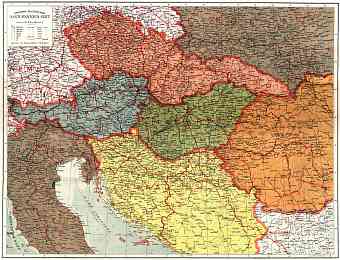
General and Railway Map of the Austro-Hungarian Empire Successor States (in Czech), 1920
26.97 x 20.62 inch, 685 x 524 mm

